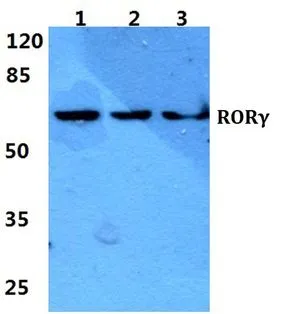ROR gamma antibody
GTX108728
ApplicationsImmunoFluorescence, Western Blot, ImmunoCytoChemistry
Product group Antibodies
ReactivityHuman
TargetRORC
Overview
- SupplierGeneTex
- Product NameROR gamma antibody
- Delivery Days Customer9
- Application Supplier NoteWB: 1:500-1:3000. *Optimal dilutions/concentrations should be determined by the researcher.Not tested in other applications.
- ApplicationsImmunoFluorescence, Western Blot, ImmunoCytoChemistry
- CertificationResearch Use Only
- ClonalityPolyclonal
- Concentration1 mg/ml
- ConjugateUnconjugated
- Gene ID6097
- Target nameRORC
- Target descriptionRAR related orphan receptor C
- Target synonymsIMD42, NR1F3, RORG, RZR-GAMMA, RZRG, TOR, nuclear receptor ROR-gamma, nuclear receptor RZR-gamma, nuclear receptor subfamily 1 group F member 3, retinoic acid-binding receptor gamma, retinoid-related orphan receptor gamma
- HostRabbit
- IsotypeIgG
- Protein IDP51449
- Protein NameNuclear receptor ROR-gamma
- Scientific DescriptionThe protein encoded by this gene is a DNA-binding transcription factor and is a member of the NR1 subfamily of nuclear hormone receptors. The specific functions of this protein are not known; however, studies of a similar gene in mice have shown that this gene may be essential for lymphoid organogenesis and may play an important regulatory role in thymopoiesis. In addition, studies in mice suggest that the protein encoded by this gene may inhibit the expression of Fas ligand and IL2. Two transcript variants encoding different isoforms have been found for this gene. [provided by RefSeq]
- ReactivityHuman
- Storage Instruction-20°C or -80°C,2°C to 8°C
- UNSPSC12352203
References
- Cho J, Kim S, Yang DH, et al. Mucosal Immunity Related to FOXP3(+) Regulatory T Cells, Th17 Cells and Cytokines in Pediatric Inflammatory Bowel Disease. J Korean Med Sci. 2018,33(52):e336. doi: 10.3346/jkms.2018.33.e336Read this paper







